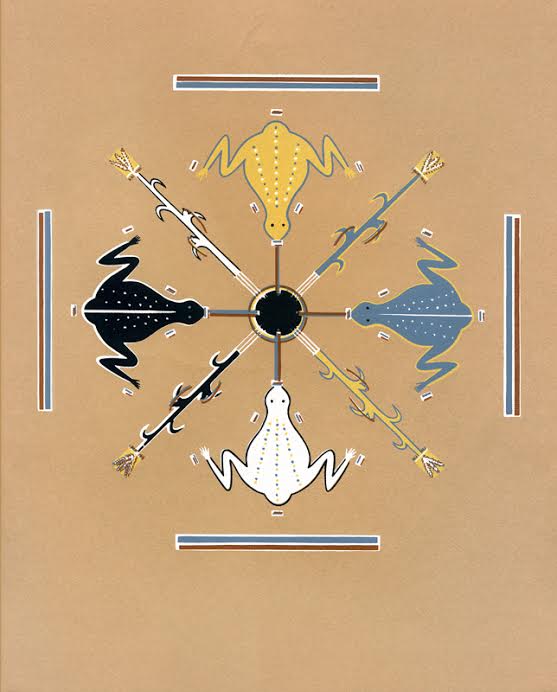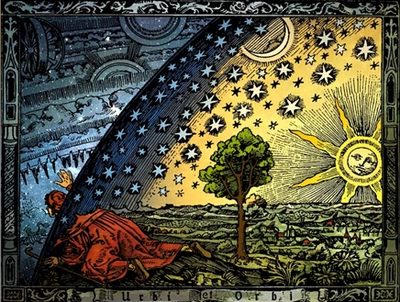ARAS Connections: Image and Archetype - 2017 Issue 3

Two extraordinarily fine papers are featured in this edition of our quarterly newsletter. They originate in our collaboration with the Art and Psyche Conferences where they were first presented. These papers have prompted me to reflect again on the meaning of our newsletter's title, ARAS Connections. “Connections” can have many different meanings—ranging from those practical “connections” that help us along the way in our lives to those far less tangible “connections” that link us to different levels of reality in ourselves, in other people, in nature, and in the cosmos. The two papers in this ARAS Connections are definitely far along the spectrum in the second category of “connections”. Both papers point to ways in which the creative act allows us to make connections between the tangible and intangible, between the known and unknown, between matter and spirit. Here is how Stefano Carta writes about the creative process of making connections between what he calls “subjective” and “objective” biography: "Little by little, as the creative autonomous contents are integrated, the creative person remembers what he is, and may feel with precision and amazement that something totally independent from his consciousness is literally creating what he is.” And, here is how Diane Fremont introduces us to the “spiracle” in the work of Cy Twombly as a channel for making connections between different realms of reality: "Dorn conceived of the spiracle as a window to eternity, a mysterious center pre-existent in us, linking us to the cosmos, while opening up and bridging the different levels of body, soul and spirit. Through the spiracle one may journey across the threshold in between the above and below, and bring traces of one world into the other and back again – a kind of conception and cross-fertilization between inconsonant realms.” We are thrilled that ARAS Connections participates in the creative activity that makes these kinds of connections possible. These unique papers encourage us to make connections in our own experience of body, psyche and spirit through images and symbols. And, finally, the Poetry Portal once again makes unexpected and illuminating connections between word and image.
Turning our attention to more mundane kinds of connections, I would like to remind our readers that ARAS Connections offers two important channels for your supporting our efforts:
1. You can contribute to ARAS by making your Amazon purchases through our link to Amazon. Simply click through to Amazon via the button in the top right menu. 6% of all purchases will go to ARAS.
2. You can connect your friends and colleagues to ARAS Connections by encouraging them to subscribe for free by simply sending their email address to newsletter@aras.org
Connectedly yours,
Tom Singer
Introduction
The following two articles Writing Stories in Time: The Unfolding of the Objective Biography by Stefano Carta and The Spiracle in Alchemy by Diane Fremont are part of our Art and Psyche series. They were originally presented at the third Art and Psyche conference held in Sicily, 2015. Diane Fremont is a Jungian analyst in New York City and Stefano Carta is a Jungian analyst who lives and works between Rome and Cagliari, Italy.
Writing Stories in Time: The Unfolding of the Objective Biography in Life and Work

In this paper I will deal with creativity and the creative process. I will not discuss the causes, or the origin of creativity, but I will try to share some reflections on one of the possible ways the creative process unfolds.
I would like to start my thoughts from three universally known Greek maxims. The first one is a Delphic saying which commands us: Γνῶθι σεαυτόν – Know thyself!, and thus indicates to us the ultimate – yet infinite – goal of human development.
The second one describes the general path that one must take: it is related to a sentence that Pindar said to its tyrant Ieron I: Γένοιο οἷος εἷ - Become who you are! This maxim is very intimately related to this article, as it indicates how one may know himself: by becoming himself, or, in other terms: by matching himself with himself in the most crucial coniunctio that I can think of.
The third and last advice is Epicurus’ admonition, which goes: Λάθε βιώσας – Live hiddenly!
If, as it is obvious, it is possible to write about creativity as something happening to and through someone else, (discussing it - so to say - in the third person), it is also possible to do it in the first person. By choosing to approach the study of the creative process through one’s own experience, one makes explicit the unavoidable personal contribution to the formation of any theory. Therefore, I will write through and about my personal experience with creativity, and, in so doing, I have myself resolved to break Epicurus’ advice.
Read Writing Stories in Time: The Unfolding of the Objective Biography in Life and Work in its entirety here.
The Spiracle in Alchemy and Art
“There is but one world, only there are many worlds within it, for it exists in more than one way at once; and these different ways cannot be translated into one another.”
(from John Crowley’s novel, “The Translator”)
The problem of “translating the untranslatable” was addressed by the 16th century alchemist Gerhard Dorn, with the notion of what he called the spiracle – in Latin, the Spiraculum Eternitatis, the window or breathing hole into eternity, which Jung writes about extensively as the conjunction of opposites in Mysterium Coniunctionis. The spiracle is described as a hole or passageway in the field of consciousness that allows the “autonomous dynamism of the collective unconscious” to break through into the realm of the personal unconscious. In this joining, it can, to some degree, be worked and translated into living, material reality, whether through word, image, other expressive means, or through lived life itself. (von Franz, 1980)
I will explore the concept of the spiracle in alchemy and in relation to the creative process, as exemplified in the work of the artist Cy Twombly, who moved back and forth between Lexington, Virginia and his adopted Southern Italy. Twombly’s work also traversed the liminal space between ancient and modern, between literature and visual art and between writing, drawing, painting, photography, collage and sculpture, embodying the idea and operations of the spiracle by linking and overlapping these disparate genres. In the studio, the inspiration of the artist, along with the tools, materials and medium, all co-create the protected space in which this passage and translation between worlds can take place. They show us ways in and ways out, ways through and ways between – giving entrée to the hidden, the unknown and the not-yet-manifest.
The Poetry Portal

In this installment of our ekphrastic writing series, poet-performer Akeema-Zane commemorates the intimacy of ritual practice in her meditation on the symbol of ASHES. If you are viewing this on a small screen or phone, you may wish to read the poem here in this pdf that preserves the formatting.
Nonsecular Non sequitur
By Akeema-Zane
in the cypher before time/ became, i traveled
beyond/ the Black sea settled/ before change
came/ before i knew i could feel/ myself outside
myself/ i smeared salt water/ peering out of my
pores/ on my tongue/ before i ran/ across the
bordering/ land mass of the Ganges/ begging for
mercies/ at its shores
Pedro de Alvarado/ rode adjacent/ toward
my back/ his back parodied/ the tail of the
iron horse/ his wrists accessorized/ in
presbyterian hospital tags/ a man, flesh/ of
unpasteurized goat’s milk,/ hair of corn silk/
stood above him projecting/ a DACA
infomercial/ from his jocote shaped face
exiting in Little Africa/ a Femme Wolof du
Cayor/ skin of used copper/ approaches me
just/ after barely beating the mouth/ of the
closing doors of steel/ her cascading linen
mouseaur/ styled to shame my own/
effort-less gold dubi pins/-an offering to the
Akan-/ black spandex headcovering,/ a
matted hair/ woolike underneath to mask
the sweat/ turning scalp to buildup/ unveiling
me with her eyes/ alone she asked/ frenetic
in her bass/ “hairbrading Miss?”
a woman, my shadow/ reflection seated
before me,/ sat composed, fighting/ the
melody of rebellion/ chords in her elbows,/
her wrists lay curled/ and fingers faced her
chin,/ she wore a black spandex/ dress,
whose seams she constantly stretched/
toward her knee/ she made adjustments as
I did my falling/ sweatpants, ether and
threaded/ in gold, she mouthed/ a tall tale to
me/ of men pulsing their breath/ into the
back of her throat/ one hand chastising her
neck/ palm to palm/ until her brain went
numb
“poetry is a coded language”/ my baba told me once/ the
sink covered in his locks/-they turned to ash-/by an electric
blade/Earth People did suffer too long/ their acres burning
wild/ fiyah bun out de bush for babash/ “White Oak rum is
all we drinking now;/ de coup, done/ and de hill people
have all fallen/ ill to St. Ann’s”/ i and i watched my
reflection/ through his in the mirror,/ my eyes watered/ as
old rusted pipe water washed/ away his sins/ never to be
born again.
Akeema-Zane is a multidisciplinary artist. Her artistic methodology is using intersectionality to configure a practice that centers the literary, cinematic and performance traditions. The aforementioned has included being artist-in-residence, student and fellow at Groundation Grenada, Cave Canem, The Maysles Documentary Center. She has also displayed visual works in various exhibitions, performed in short films/music videos and plays, and most recently published liner notes to album Conjur Woman. Additionally she has collaborated with various musicians, and is featured on the album and short film BRWN . Her published work include There's a Monopoly on Change, On Being the Daughter Discovering the Home of her Descendants… , Interlude, and When Money Can't Buy You Home. She is of Afro-Caribbean descent and is a native New Yorker.
Contents
Become a Member of ARAS!
Become a member of ARAS Online and you'll receive free, unlimited use of the entire archive of 17,000 images and 20,000 pages of commentary any time you wish—at home, in your office, or wherever you take your computer.
The entire contents of three magnificent ARAS books: An Encyclopedia of Archetypal Symbolism, The Body and The Book of Symbols are included in the archive. These books cost $330 when purchased on their own.
You can join ARAS Online instantly and search the archive immediately. If you have questions, please call (212) 697-3480 or email info@aras.org
We Value Your Ideas
As our newsletter grows to cover both the ARAS archive and the broad world of art and psyche, we're eager to have your suggestions and thoughts on how to improve it. Please send your comments to info@aras.org. We look forward to your input and will reply to every message.
Subscribe
If you're not already a subscriber and would like to receive subsequent issues of this newsletter by email at no cost, e-mail us at newsletter@aras.org.
